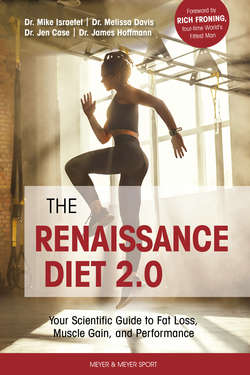Читать книгу The Renaissance Diet 2.0 - Mike Israetel, James Hoffmann - Страница 29
На сайте Литреса книга снята с продажи.
CALORIES
ОглавлениеIn the simplest terms, a calorie is a unit of measurement for energy. In the strictest sense, a calorie (which actually refers to a kilocalorie) is the amount of heat required to raise the temperature of one kilogram of water from 14.5 to 15.5 degrees Celsius. Interesting, but not very helpful when sitting down and deciding what to eat.
In nutrition, calories measure how much energy we get from food to either use or store in our bodies. Calories can be used to jump, run, operate your brain, recover from hard training, repair broken structures, or simply support the energy requirements of normal body function. An individual might use 2,000 calories a day to meet all of their energy needs, including everything from walking over to pick up the telephone to the firing of neurons in the brain to read this very text.
When someone needs 2,000 calories per day to function, but only consumes 1,700, they do not simply stop breathing or lose the ability to walk or think. The body has a back-up plan for when calories are scarce. Our ancestors did not have local grocery stores or refrigeration, so our bodies are adapted to deal with some periods of calorie deficit without extensive damage to health or function. In the previous example, the body can acquire the additional 300 calories it needs to sustain itself by breaking down some of its own tissues (most commonly fat) to release stored energy. There is a tremendous amount of stored energy in your adipose tissue. While your body does burn fats for fuel in the absence of sufficient food, it can also break down other structures, such as the proteins that compose your muscles. A variety of factors determine which of the body’s tissues are broken down for energy and in what amount, but the primary factor deciding whether the body’s structures will be accessed at all is calorie balance. When your body is getting enough food per day to meet all of its energy needs, we call this an isocaloric or eucaloric condition. Isocaloric conditions result in bodyweight maintenance–stable bodyweight over time.
When your body is not getting enough calories per day to meet energy needs, it must break down some of its own tissue for the missing energy. This dietary condition is termed hypocaloric and results in weight loss. If you take in more energy than you need, your body stores much of it as carbohydrate, protein, and fat molecules, with fat being the most common. We call this a hypercaloric condition, and as you may have already guessed, it results in weight gain.
Figure 2.1 On an isocaloric diet, calorie consumption matches the body’s calorie demand. During a hypocaloric diet, fewer calories are being consumed relative to the body’s daily demand (designated by bracket A) On a hypercaloric diet, excess calories are being ingested (designated by bracket B).
